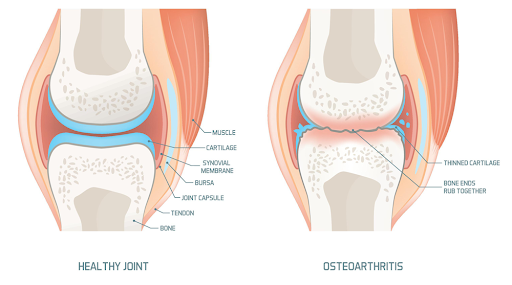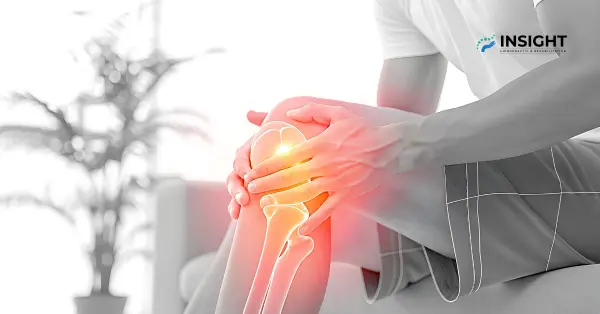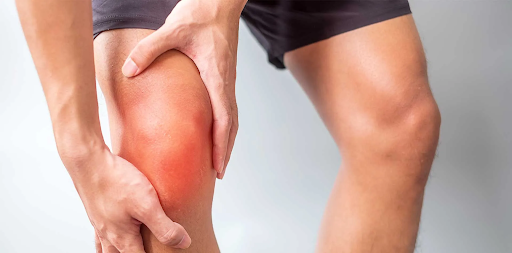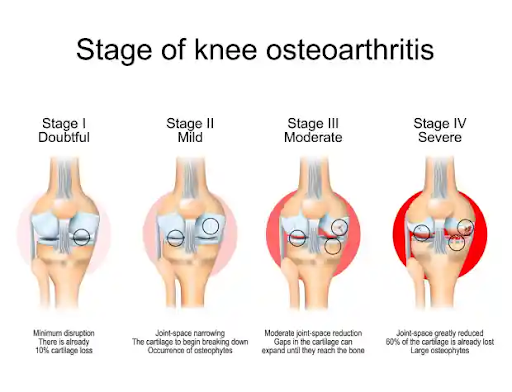Wear and tear of our spine and joints is a natural part of the aging process. However, if left uncontrolled due to factors such as sedentary lifestyle, overweight, past trauma and poor posture, it can lead to a painful condition called osteoarthritis (OA).
Chiropractic care specializes in managing osteoarthritis (OA) by alleviating pain, enhancing mobility, improving quality of life and slowing its progression.
While many people may associate chiropractic care with spinal adjustments and cracking sounds, it is much more than that. Chiropractic care also plays a vital role in managing joint conditions and improving overall musculoskeletal health.
What is Osteoarthritis?

Osteoarthritis is a common condition where the cartilage (a protective cushion between bones) gradually wears down over time. This can occur naturally with aging or be accelerated by injuries, repetitive stress, or poor posture.
Who Is Most at Risk?
- Age:
OA risk increases as we age; the cartilage naturally wears out and the natural fluid that acts as lubricant decreases over time. - Gender:
Women, especially after menopause, are more likely to develop OA due to the drop of estrogen levels which leads to increased cartilage breakdown. - Sports and Physical Activity:
High-impact activities that involve running, jumping and pivoting such as basketball, football, etc. creates more stress in the knee which results in quicker cartilage breakdown. - Obesity:
Excess weight adds stress to joints, especially the knees. - Genetics:
In rare instances, some individuals inherit a higher tendency for joint degeneration. - Repetitive Motion Jobs:
Occupations such as assembly line workers, construction workers, and hairdressers often involve repetitive joint motions or long hours on their feet, which can cause chronic joint stress over time.
How OA Develops?
When cartilage wears down, bones begin to rub against each other, causing pain, stiffness and inflammation. Over time, the body may form bone spurs (aka osteophytes) which can further limit mobility and cause discomfort.
Signs and Symptoms of Osteoarthritis
Commonly Affected Areas
Osteoarthritis can impact any joint, but weight-bearing joints such as the knees, hips, and spine are most affected. It also commonly develops in the thumbs and shoulders.
Symptoms to Watch For
- Joint pain and stiffness, especially after rest
- Swelling and tenderness
- Reduced range of motion
- Clicking or grinding sensations during movement
Stages of Osteoarthritis (Grade 1-4)
- Mild (Grade 1): Minor wear with little or no discomfort.
- Moderate (Grade 2): Noticeable stiffness and pain with activity.
- Severe (Grade 3): Significant cartilage loss and restricted movement.
- Advanced (Grade 4): Severe pain, near-total cartilage loss, and major mobility issues.
How Chiropractic Care Helps Manage Osteoarthritis
Chiropractic care can improve joint function and relieve discomfort through various treatments.
Spinal and Joint Adjustments:
These realign joints, reducing stress and improving movement. Mobilization techniques also enhance mobility, making daily activities easier.
Soft Tissue Therapy:
Overworked muscles can worsen OA symptoms. Chiropractors identify and relieve tension in tight and overworked muscles through soft tissue massages.
TECAR Therapy:
This therapy utilises endogenous heat to speed up tissue healing, reduces swelling, and enhances blood circulation, helping to relieve OA pain.
EMS (Electrical Muscle Stimulation):
EMS reduces pain by stimulating muscles, increasing circulation, and preventing muscle weakness due to inactivity.
ESWT Shockwave Therapy:
Shockwave Therapy uses acoustic waves to stimulate tissue repair, improve blood flow, and reduce inflammation in affected joints. It can ease chronic pain, relax tight muscles, and promote faster recovery when combined with chiropractic adjustments.
Other Treatment Options to Consider
In addition to chiropractic care, other conservative treatments can help manage OA symptoms:
- Physiotherapy:
Physiotherapy plays a crucial role in managing osteoarthritis by designing personalized exercise programs that focus on strengthening the muscles around affected joints, improving mobility, and promoting better movement patterns. - Braces & Orthotics:
Provide additional joint support.
Best Foods for Joint Health and Reducing Inflammation
A healthy diet is a key part of easing osteoarthritis symptoms by reducing inflammation and supporting cartilage health.
What to Eat:
- Omega-3 Fatty Acids: Found in salmon, flaxseeds, and walnuts to fight inflammation.
- Leafy Greens: Loaded with antioxidants to protect joints.
- Turmeric and Ginger: Natural anti-inflammatory agents.
- Collagen-Rich Foods: Bone broth and gelatin help maintain cartilage.
What to Avoid:
- Processed Sugars & Refined Carbs: These can trigger inflammation.
- Excessive Red Meat: May increase joint pain.
- High-Sodium Foods: Can lead to swelling and stiffness.
Conclusion: What to Expect from Chiropractic Care for Osteoarthritis
Chiropractic care provides a safe, non-invasive approach to managing osteoarthritis effectively. A personalised treatment plan, including spinal adjustments, TECAR therapy, and EMS can significantly reduce pain and improve mobility. Combined with proper nutrition and healthy lifestyle changes, chiropractic care helps osteoarthritis patients maintain an active and fulfilling life.
Osteoarthritis is a lifelong condition, but with the right strategies, you can stay mobile, active, and pain-free. If you or a loved one is experiencing joint pain, consider visiting a chiropractor to explore your options for a healthier future.







